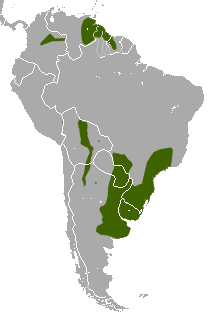Lutrine opossum
| Lutrine opossum | |
|---|---|
 |
|
| Scientific classification | |
| Kingdom: | Animalia |
| Phylum: | Chordata |
| Class: | Mammalia |
| Infraclass: | Marsupialia |
| Order: | Didelphimorphia |
| Family: | Didelphidae |
| Subfamily: | Didelphinae |
| Genus: |
Lutreolina Thomas, 1910 |
| Species: | L. crassicaudata |
| Binomial name | |
|
Lutreolina crassicaudata Desmarest, 1804 |
|
| Subspecies | |
|
L. crassicaudata crassicaudata |
|
 |
|
| Lutrine opossum range | |
L. crassicaudata crassicaudata
L. crassicaudata paranalis
L. crassicaudata turneri
The lutrine opossum (Lutreolina crassicaudata), also known as the little water opossum, thick-tailed opossum, or coligrueso is an opossum species from South America and is monotypic in the genus Lutreolina.
The lutrine opossum ("lutrine" means "otter-like" and "crass" meaning "thick, fat" and "cauda" meaning "tail") is a very peculiar opossum, having a long weasel-like body, short legs small rounded ears, and dense reddish or yellowish fur. Nocturnal and crepuscular, they generally live in grasslands and savannas near water. They are terrestrial but are excellent swimmers and climbers.
Genetic and morphological studies indicate that there is a second species, Lutreolina massoia.
Lutreolina crassicaudata is found in Brazil, Argentina, Bolivia, Uruguay, Paraguay, Colombia and Guyana. Populations in the two last countries are isolated from the populations of all the other countries. It can be found in grasslands, savanna grassland, and gallery woodlands with permanent water bodies, in marshy or riparian habitats. They build tight nests made of grass and reeds or utilize abandoned armadillo or viscacha burrows
With a skull adapted for carnivory, Lutrine opossums are carnivorous and insectivorous feeding on small rodents and lagomorphs, birds, insects, small crustaceans. They are considered to be the most carnivorous of all the members of the order Didelphimorphia. Captive populations have been observed eating butterfish mixed with meat, frogs, earthworms, shrimp at mice. Populations located close to urban areas have been known to scavenge through garbage but this behavior is isolated to these populations and likely occurs due necessity because there is less available prey in urban areas.
Fossils found in Minas Gerais, Brazil indicate that Didelphys crassicaudata emerged in the late epoch. Lutreolina fossils found in Tarija, Bolivia as well as samples uncovered across Argentina also indicate appearance of lutrine opossum ancestors during the late Pleistocene. For a short time in Argentina, the opossums were hunted for their pelts for fur trade and to line garments. But this market quickly declined because the color of the opossum pelts would fade over time.
...
Wikipedia

